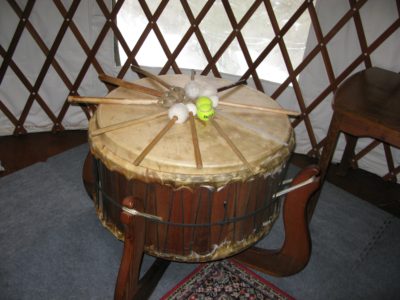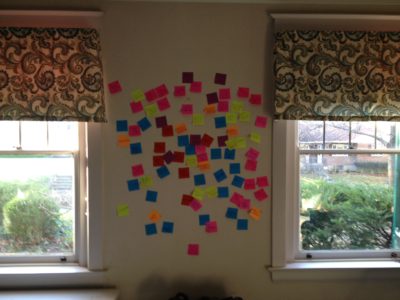This article was posted on The Circle Way website. I’ve also uploaded a PDF version here.
ad

It starts with a drum beat, often. Eleven of us, all men, aged between late 30s and mid 70s, standing together around a three foot diameter drum suspended before us. We each have a drum stick, which we begin to use together in simple, collective beat. The drum itself has a story of where it came from, just as we eleven each have a story of where we came from, that we are eager to explore in this semi-annual retreat. “We” includes those that work in regular 9:00 – 6:00 jobs. Some are retired from 30-40 years of career, and wondering what is next. Some now volunteer with local communities. Some are fathers, and sons. There is ceremony in this drumming together, in this beginning. It feels natural and potent. We are gathered for men’s work, which will have many aspects to it. Circle and it’s premises will help us shift from social connection to a deep listening group of men together.
Circle will help us find our stories together. Get past an initial not knowing what to say with each other. A bit like an oxygen mask restores what our autonomous nervous system knows to do — breath and restore circulation. We will pass a talking piece. Many times over three days together. Each of us will have opportunity to share, to think out loud. Each of us will have opportunity to witness and do what is long forgotten for many, yet so needed. We will debunk a pervasive mythology that we are alone in our stories, and that we should carry them in separateness. Alone in our suppressed emotions. Alone in our not knowing how to return to what American poet and author, Robert Bly calls “original radiance.”
From many experiences over the last twenty years (in most, 25% men and 75% women), I havelearned that men want to be thoughtful together. Whether in men’s work, or in the contemporary lives of leadership as doctors, lawyers, government officials, educators, mechanics, plumbers and such. It’s just a story that men don’t want to share, or can’t share. Men want to share openly. Men have much to contribute.
My friend and colleague Quanita Roberson started a project a few years ago that demonstrated this yearning that men have to contribute. Her project started as a a few bits of advice to gift to a thirteen year old boy, but then turned into a book. She asked me and 65 other men, “What do you wish someone would have told you when you were 13?” The men she asked ranged from their 20s to 70s, were born and raised in eleven different countries, and were from diverse stages of life, artistry, spirituality and sexual orientation.
Says Quanita, “What struck me most in their responses was how generous and thoughtful they were in sharing their wisdom with me, and therefore with Jason, a boy that only one of them knew. In the questioning, and their answering, I realized that we [as contemporary society] are asking men for everything but their wisdom, and that they are desperate to share it. There is something in them that knows this wisdom is needed now. There is something in them that knows our boys are lost without it. Maybe some of them have been lost without it as well.”
Wise together. It’s different than wise alone. There may not be a drum in the room. But there will always be the possibility of a circle. Men, joining with women, people joining together, to be wise. Many men, but gladly not all, have just forgotten form in a way that many woman have not. We’ve forgotten how helpful it can be to slow down to listen with ample pauses. To include silence as part of our speaking. To just feel, not fix. To elder each other into a presence and ability to stand in today’s complex world.
The circle is for men too. Never doubt it. This is a call to men. Men, please hear it. Join in circle. Make it part of you. Make it part of your leadership. Be part of an evolving and available healthy masculine. Listen. Share. Discover. Be moved. Be moving.
It was one of the other men, Chandu, whom I have met now at two weekend events, who summed it up nicely for Quanita’s book given to her 13 year-old friend. “Remember perfect doesn’t mean infallible; frail doesn’t mean weak; strong doesn’t mean right. Start with empathy; love will follow.” That’s what men have to contribute, and remember in circle.
—–
A footnote: I read a draft of this article to my 11 year-old son. I think I wanted to share it with him to seed an idea and alertness in him, perhaps more for his future 21 year-old self. He was working on a picture puzzle when I read it to him, moving the orange colored pieces around at that moment. I asked him if it would be ok for me to read to him what I’d been writing. His response surprised and delighted me, which he added without blinking. “I have one more thing to add. Men have been mean, you know. Like not letting woman vote. And they have been told to protect their families and told not to cry. But men have feelings too. They’ve just been taught to keep them inside and not share them. But we need to because if we can’t it can hurt you for the rest of your life. And now women are acting like men used to act. Some are being mean. That’s not right. We all need to be who we are. And let it out. It’s awful not to. We all have things to say, but we are scared of being judged.” Maybe Quanita’s next book might be asking a bunch of 11 year-olds what they want to say to grown men.





